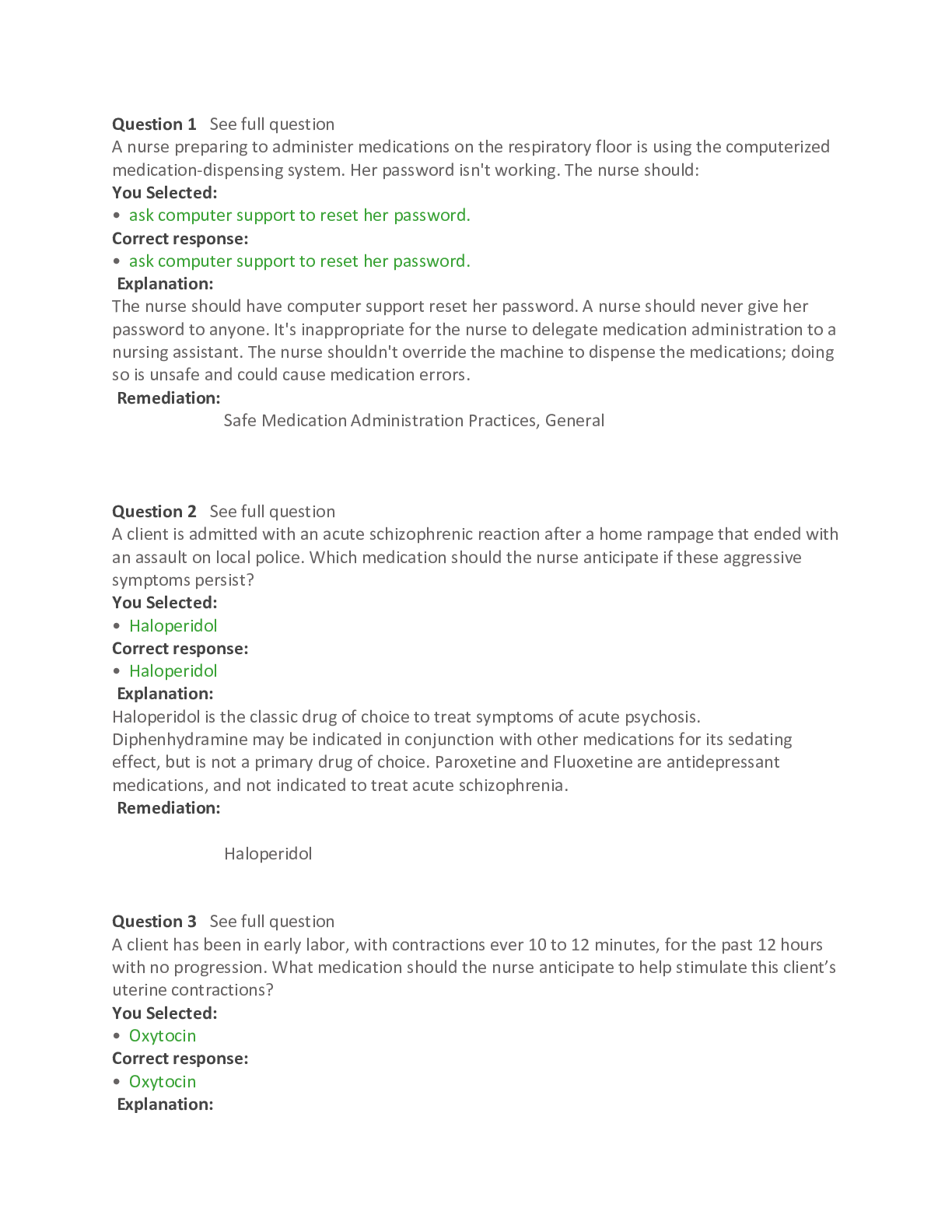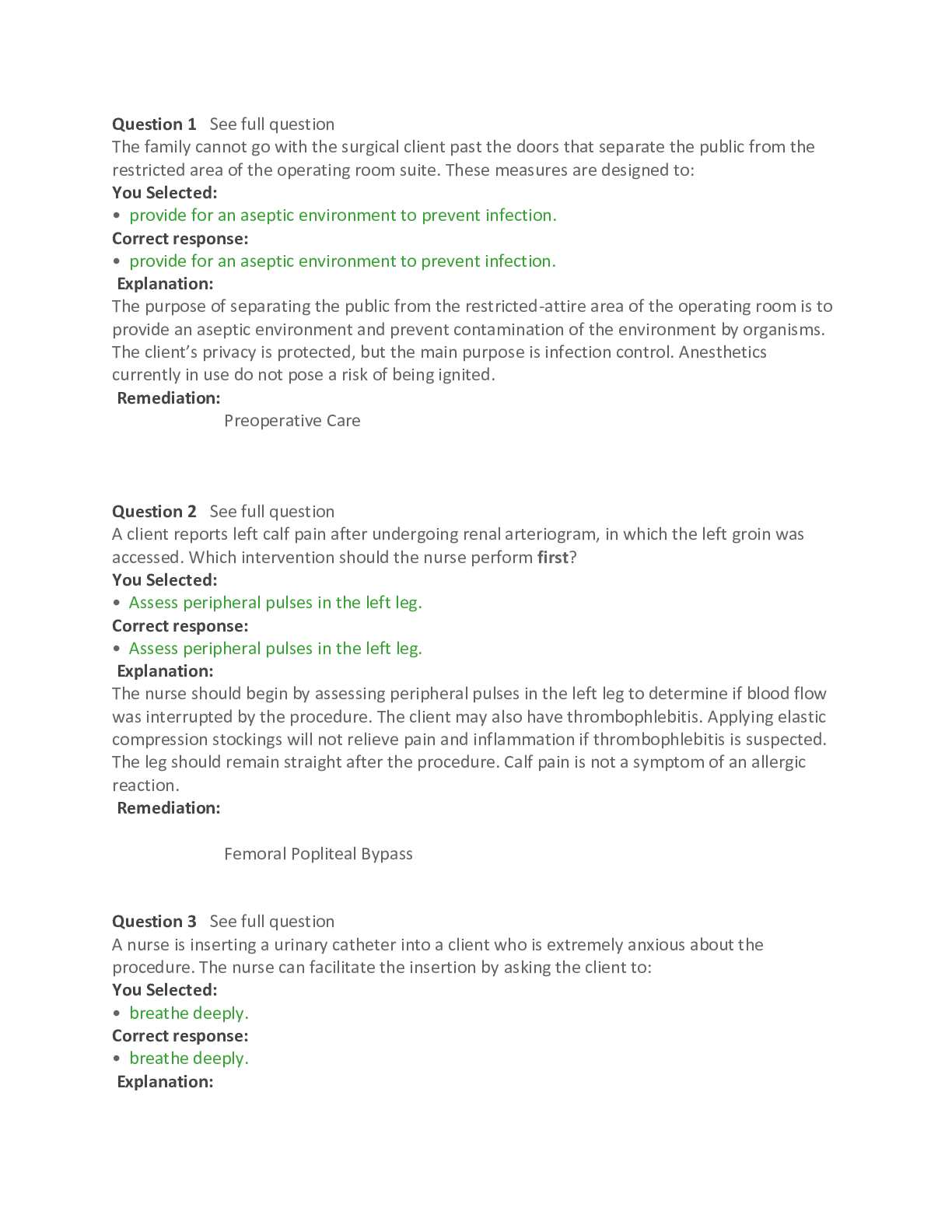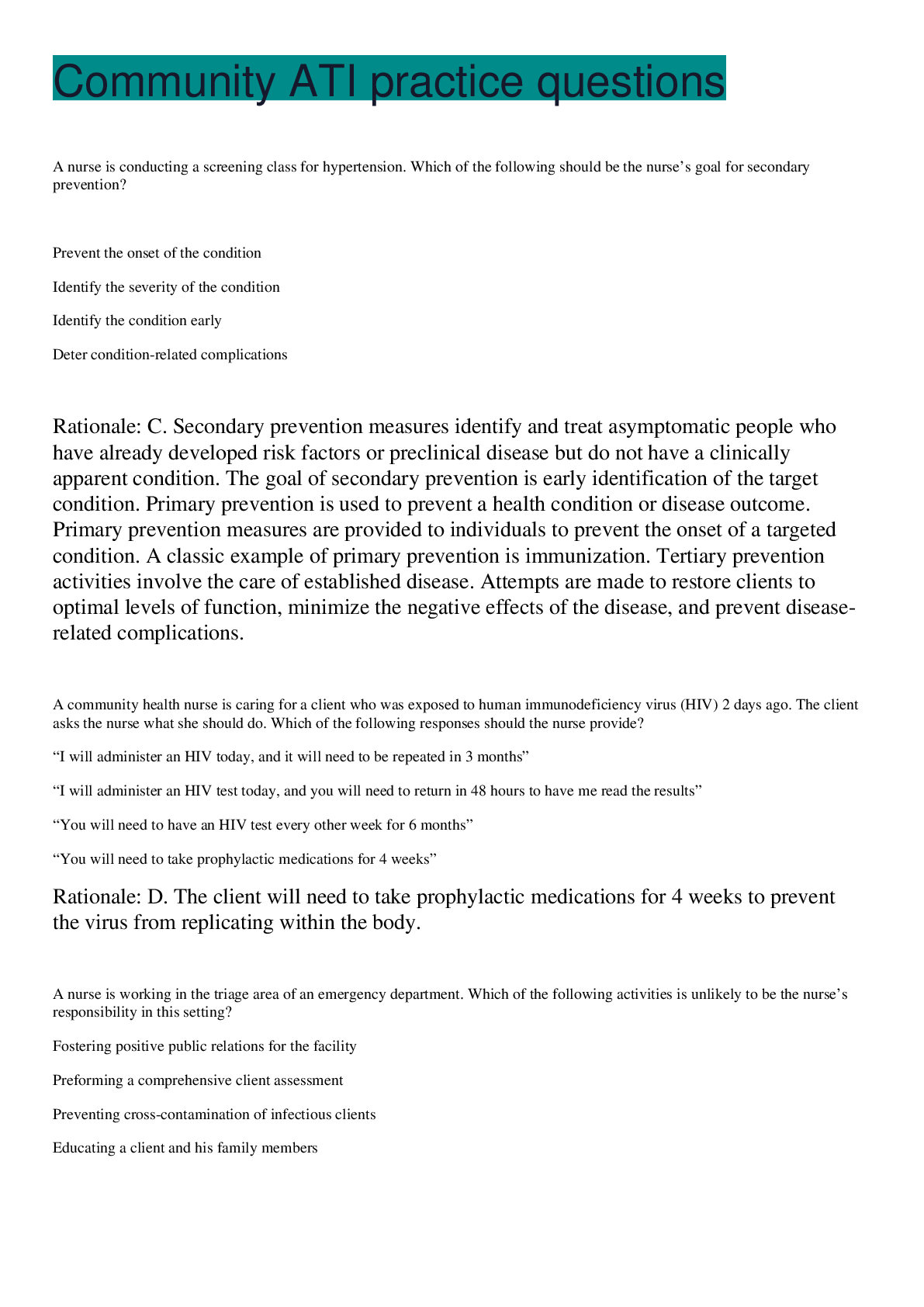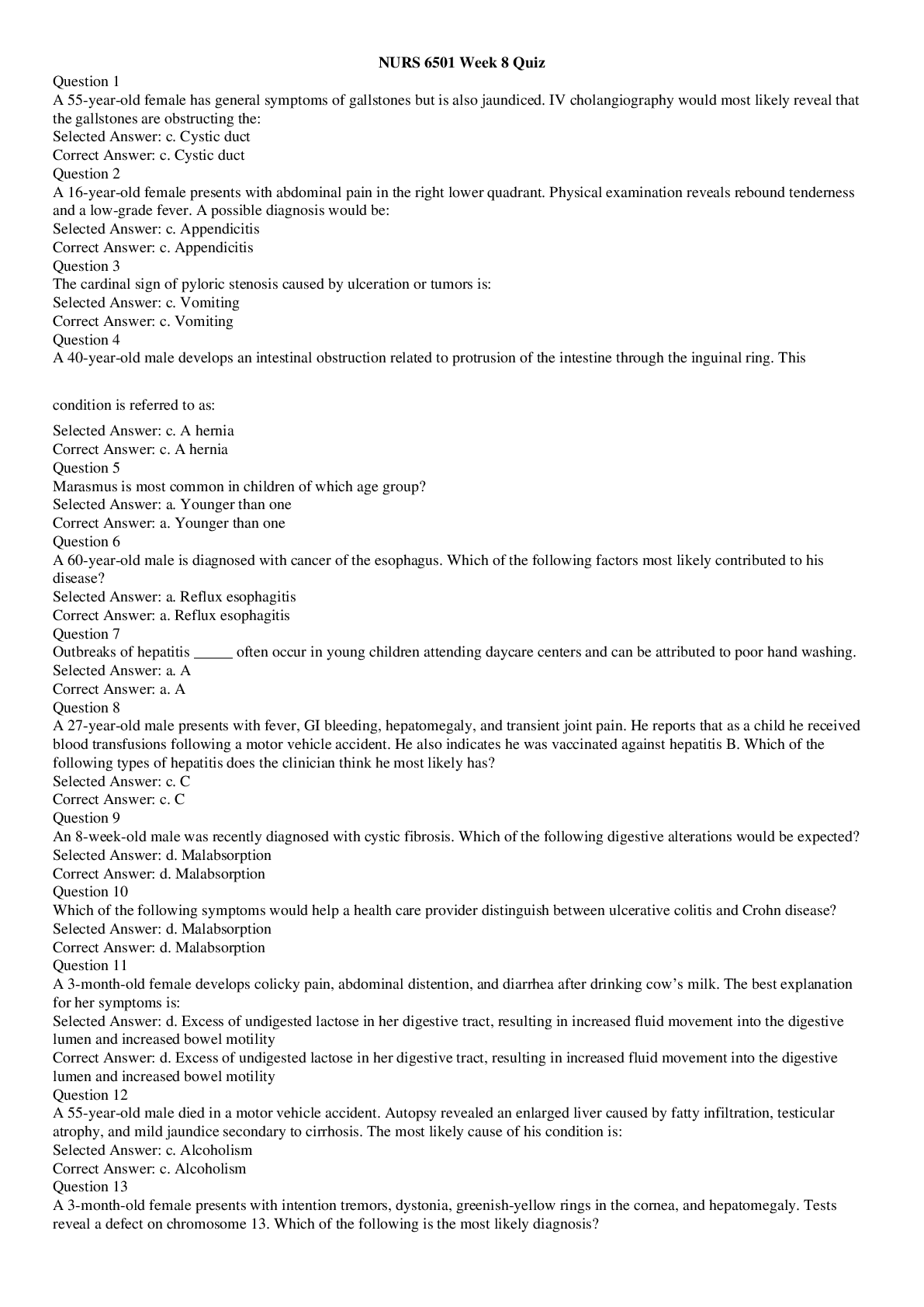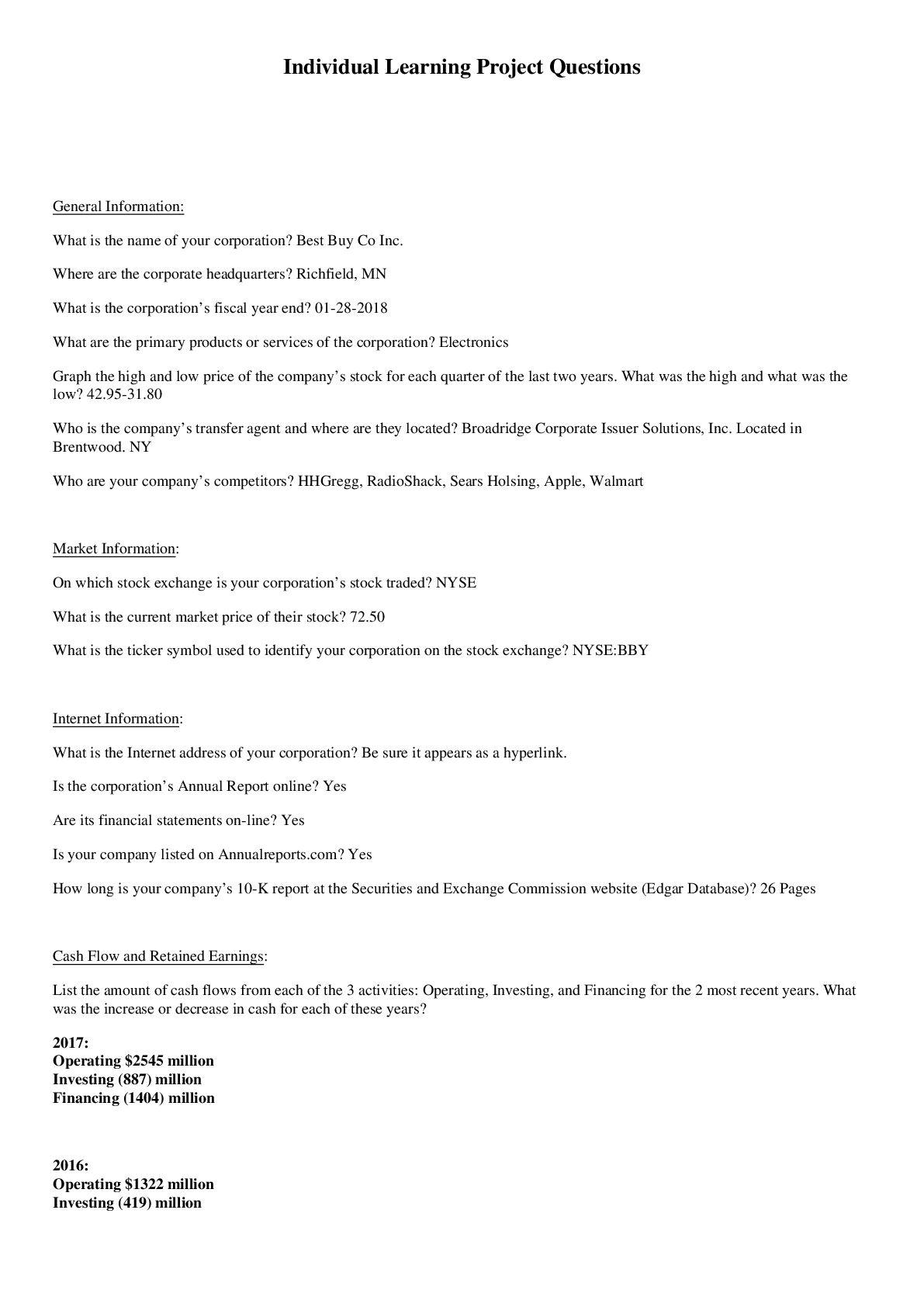*NURSING > STUDY GUIDE > NURSING | NCLEX Exam 2 Test Bank | Questions and Answers (Latest Spring 2022/2023) Verified A+ Guide (All)
NURSING | NCLEX Exam 2 Test Bank | Questions and Answers (Latest Spring 2022/2023) Verified A+ Guide.
Document Content and Description Below
NCLEX Exam 2 Test Bank | Questions and Answers (Latest Spring 2022/2023) University of Alaska, Anchorage NCLEX Exam 2 Cardiac A client admitted to the hospital with chest pain and a history of type 2 ... diabetes mellitus is scheduled for cardiac catheterization. Which medication would need to be withheld for 24 hours before the procedure and for 48 hours after the procedure? A client who had cardiac surgery 24 hours ago has had a urine output averaging 20 mL/hour for 2 hours. The client received a single bolus of 500 mL of intravenous fluid. Urine output for the subsequent hour was 25 mL. Daily laboratory results indicate that the blood urea nitrogen level is 45 mg/dL (16 mmol/L) and the serum creatinine level is 2.2 mg/dL (194 mcmol/L). On the basis of these findings, the nurse would anticipate that the client is at risk for which problem? The nurse is reviewing an electrocardiogram rhythm strip. The P waves and QRS complexes are regular. The PR interval is 0.16 seconds, and QRS complexes measure 0.06 seconds. The overall heart rate is 64 beats/minute. Which action should the nurse take? A client is wearing a continuous cardiac monitor, which begins to sound its alarm. The nurse sees no electrocardiographic complexes on the screen. Which is the priority nursing action? The nurse is evaluating a client's response to cardioversion. Which assessment would be the priority? The nurse is caring for a client who has just had implantation of an automatic internal cardioverter-defibrillator. The nurse should assess which item based on priority? A client's electrocardiogram strip shows atrial and ventricular rates of 110 beats/minute. The PR interval is 0.14 seconds, the QRS complex measures 0.08 seconds, and the PP and RR intervals are regular. How should the nurse correctly interpret this rhythm? The nurse is assessing the neurovascular status of a client who returned to the surgical nursing unit 4 hours ago after undergoing aortoiliac bypass graft. The affected leg is warm, and the nurse notes redness and edema. The pedal pulse is palpable and unchanged from admission. How should the nurse correctly interpret the client's neurovascular status? The nurse is evaluating the condition of a client after pericardiocentesis performed to treat cardiac tamponade. Which observation would indicate that the procedure was effective? A client with variant angina is scheduled to receive an oral calcium channel blocker twice daily. Which statement by the client indicates the need for further teaching? The nurse is monitoring a client with acute pericarditis for signs of cardiac tamponade. Which assessment finding indicates the presence of this complication? The home care nurse is providing instructions to a client with an arterial ischemic leg ulcer about home care management and self-care management. Which statement, if made by the client, indicates a need for further instruction? The nurse is providing instructions to a client with a diagnosis of hypertension regarding high-sodium items to be avoided. The nurse instructs the client to avoid consuming which item? The nurse is preparing discharge instructions for a client with Raynaud's disease. The nurse should plan to provide which instruction to the client? The nurse is developing a plan of care for a client with varicose veins in whom skin breakdown occurred over the varicosities as a result of secondary infection. Which is a priority intervention? The nurse in the medical unit is reviewing the laboratory test results for a client who has been transferred from the intensive care unit (ICU). The nurse notes that a cardiac troponin T assay was performed while the client was in the ICU. The nurse determines that this test was performed to assist in diagnosing which condition? The nurse is caring for a client with cardiac disease who has been placed on a cardiac monitor. The nurse notes that the client has developed atrial fibrillation and has a rapid ventricular rate of 150 beats/minute. The nurse should next assess the client for which finding? The nurse is performing an assessment on a client with a diagnosis of left-sided heart failure. Which assessment component would elicit specific information regarding the client's left-sided heart function? The nurse is participating in a class on rhythm strip interpretation. Which statement by the nurse indicates an understanding of a PR interval of 0.20? The nurse in the medical unit is assigned to provide discharge teaching to a client with a diagnosis of angina pectoris. The nurse is discussing lifestyle changes that are needed to minimize the effects of the disease process. The client continually changes the subject during the teaching session. The nurse interprets that this client's behavior is most likely related to which problem? A home care nurse is visiting a client to provide follow-up evaluation and care of a leg ulcer. On removing the dressing from the leg ulcer, the nurse notes that the ulcer is pale and deep and that the surrounding tissue is cool to the touch. The nurse should document that these findings identify which type of ulcer? The nurse is developing a plan of care for a client who will be admitted to the hospital with a diagnosis of deep vein thrombosis (DVT) of the right leg. The nurse develops the plan, expecting that the health care provider (HCP) will most likely prescribe which option? A client with a diagnosis of varicose veins is scheduled for treatment by sclerotherapy and is receiving education about the procedure from the nurse. Which statement by the client indicates that the teaching has been effective? A client calls the nurse at the clinic and reports that ever since the vein ligation and stripping procedure was performed, she has been experiencing a sensation as though the affected leg is falling asleep. The nurse should make which response to the client? The registered nurse (RN) is educating a new RN about the use of oxygen for clients with angina pectoris. Which statement by the new nurse indicates that the teaching has been effective? A client with a diagnosis of angina pectoris is hospitalized for an angioplasty. The client returns to the nursing unit after the procedure, and the nurse provides instructions to the client regarding home care measures. Which statement, if made by the client, indicates an understanding of the instructions? The nurse is caring for a client with a diagnosis of myocardial infarction (MI) and is assisting the client in completing the diet menu. Which beverage should the nurse instruct the client to select from the menu? The nurse is performing an admission assessment on a client with a diagnosis of angina pectoris who takes nitroglycerin for chest pain at home. During the assessment the client complains of chest pain. The nurse should immediately ask the client which question? The nurse has provided dietary instructions to a client with coronary artery disease. Which statement by the client indicates an understanding of the dietary instructions? A client is admitted to the visiting nurse service for assessment and follow-up after being discharged from the hospital with new-onset heart failure (HF). The nurse teaches the client about the dietary restrictions required with HF. Which statement by the client indicates that further teaching is needed? The nurse is performing a health screening on a 54-year-old client. The client has a blood pressure of 118/78 mm Hg, total cholesterol level of 190 mg/dL (4.9 mmol/L), and fasting blood glucose level of 184 mg/dL (10.2 mmol/L). The nurse interprets this to mean that the client has which modifiable risk factor for coronary artery disease (CAD)? The nurse is trying to determine the ability of the client with myocardial infarction (MI) to manage independently at home after discharge. Which statement by the client is the strongest indicator of the potential for difficulty after discharge? The home care nurse has taught a client with a problem of inadequate cardiac output about helpful lifestyle adaptations to promote health. Which statement by the client best demonstrates an understanding of the information provided? A client has been experiencing difficulty with completion of daily activities because of underlying cardiovascular disease, as evidenced by exertional fatigue and increased blood pressure. Which observation by the nurse best indicates client progress in meeting goals for this problem? The health care provider (HCP) has written a prescription for a client to have an echocardiogram. Which action should the nurse take to prepare the client for the procedure? A client with coronary artery disease is scheduled to have a diagnostic exercise stress test. Which instruction should the nurse plan to provide to the client about this procedure? A client is scheduled for a cardiac catheterization to diagnose the extent of coronary artery disease. The nurse places the highest priority on telling the client to report which sensation during the procedure? A client recovering from pulmonary edema is preparing for discharge. What should the nurse plan to teach the client to do to manage or prevent recurrent symptoms after discharge? A client is scheduled to undergo cardiac catheterization for the first time, and the nurse provides instructions to the client. Which client statement indicates an understanding of the instructions? A client admitted to the hospital with coronary artery disease complains of dyspnea at rest. The nurse caring for the client uses which item as the best means to monitor respiratory status on an ongoing basis? Ear The nurse is performing an otoscopic examination on a client with mastoiditis. On examination of the tympanic membrane, which finding should the nurse expect to observe? A client is diagnosed with a disorder involving the inner ear. Which is the most common client complaint associated with a disorder involving this part of the ear? The nurse is caring for a client following craniotomy for removal of an acoustic neuroma. Assessment of which cranial nerve would identify a complication specifically associated with this surgery? The nurse notes that the health care provider has documented a diagnosis of presbycusis on a client's chart. Based on this information, what action should the nurse take? A client with Ménière's disease is experiencing severe vertigo. Which instruction should the nurse give to the client to assist in controlling the vertigo? The nurse is caring for a hearing-impaired client. Which approach will facilitate communication? Endocrine A client is brought to the emergency department in an unresponsive state, and a diagnosis of hyperosmolar hyperglycemic syndrome is made. The nurse would immediately prepare to initiate which anticipated health care provider's prescription? An external insulin pump is prescribed for a client with diabetes mellitus. When the client asks the nurse about the functioning of the pump, the nurse bases the response on which information about the pump? A client with a diagnosis of diabetic ketoacidosis (DKA) is being treated in the emergency department. Which findings support this diagnosis? Select all that apply. The nurse teaches a client with diabetes mellitus about differentiating between hypoglycemia and ketoacidosis. The client demonstrates an understanding of the teaching by stating that a form of glucose should be taken if which symptom or symptoms develop? Select all that apply. A client with diabetes mellitus demonstrates acute anxiety when admitted to the hospital for the treatment of hyperglycemia. What is the appropriate intervention to decrease the client's anxiety? The nurse provides instructions to a client newly diagnosed with type 1 diabetes mellitus. The nurse recognizes accurate understanding of measures to prevent diabetic ketoacidosis when the client makes which statement? A client is admitted to a hospital with a diagnosis of diabetic ketoacidosis (DKA). The initial blood glucose level is 950 mg/dL (54.2 mmol/L). A continuous intravenous (IV) infusion of short-acting insulin is initiated, along with IV rehydration with normal saline. The serum glucose level is now decreased to 240 mg/dL (13.7 mmol/L). The nurse would next prepare to administer which medication? The nurse is monitoring a client newly diagnosed with diabetes mellitus for signs of complications. Which sign or symptom, if exhibited in the client, indicates that the client is at risk for chronic complications of diabetes if the blood glucose is not adequately managed? The nurse is preparing a plan of care for a client with diabetes mellitus who has hyperglycemia. The nurse places priority on which client problem? The home health nurse visits a client with a diagnosis of type 1 diabetes mellitus. The client relates a history of vomiting and diarrhea and tells the nurse that no food has been consumed for the last 24 hours. Which additional statement by the client indicates a need for further teaching? The nurse is caring for a client after hypophysectomy and notes clear nasal drainage from the client's nostril. The nurse should take which initial action? The nurse is admitting a client who is diagnosed with syndrome of inappropriate antidiuretic hormone secretion (SIADH) and has serum sodium of 118 mEq/L (118 mmol/L). Which health care provider prescriptions should the nurse anticipate receiving? Select all that apply. A client is admitted to an emergency department, and a diagnosis of myxedema coma is made. Which action should the nurse prepare to carry out initially? The nurse is caring for a client admitted to the emergency department with diabetic ketoacidosis (DKA). In the acute phase, the nurse plans for which priority intervention? A client with type 1 diabetes mellitus calls the nurse to report recurrent episodes of hypoglycemia with exercising. Which statement by the client indicates an adequate understanding of the peak action of NPH insulin and exercise? The nurse is completing an assessment on a client who is being admitted for a diagnostic workup for primary hyperparathyroidism. Which client complaint would be characteristic of this disorder? Select all that apply. The nurse is teaching a client with hyperparathyroidism how to manage the condition at home. Which response by the client indicates the need for additional teaching? A client with a diagnosis of Addisonian crisis is being admitted to the intensive care unit. Which findings will the interprofessional healthcare team focus on? Select all that apply. The nurse is monitoring a client who was diagnosed with type 1 diabetes mellitus and is being treated with NPH and regular insulin. Which manifestations would alert the nurse to the presence of a possible hypoglycemic reaction? Select all that apply The nurse is performing an assessment on a client with pheochromocytoma. Which assessment data would indicate a potential complication associated with this disorder? The nurse is monitoring a client diagnosed with acromegaly who was treated with transsphenoidal hypophysectomy and is recovering in the intensive care unit. Which findings should alert the nurse to the presence of a possible postoperative complication? Select all that apply. The nurse performs a physical assessment on a client with type 2 diabetes mellitus. Findings include a fasting blood glucose level of 120 mg/dL (6.8 mmol/L), temperature of 101°F (38.3°C), pulse of 102 beats/minute, respirations of 22 breaths/minute, and blood pressure of 142/72 mm Hg. Which finding would be the priority concern to the nurse? The nurse is preparing a client with a new diagnosis of hypothyroidism for discharge. The nurse determines that the client understands discharge instructions if the client states that which signs and symptoms are associated with this diagnosis? Select all that apply. A client has just been admitted to the nursing unit following thyroidectomy. Which assessment is the priority for this client? A client has been diagnosed with hyperthyroidism. The nurse monitors for which signs and symptoms indicating a complication of this disorder? Select all that apply. The nurse is caring for a client scheduled for a transsphenoidal hypophysectomy. The preoperative teaching instructions should include which statement? The nurse should include which interventions in the plan of care for a client with hypothyroidism? Select all that apply. A client with Cushing's syndrome verbalizes concern to the nurse regarding the appearance of the buffalo hump that has developed. Which statement should the nurse make to the client? The nurse is caring for a client after thyroidectomy. The nurse notes that calcium gluconate is prescribed for the client. The nurse determines that this medication has been prescribed for which purpose? A client with type 1 diabetes mellitus is to begin an exercise program, and the nurse is providing instructions regarding the program. Which instruction should the nurse include in the teaching plan? The nurse should include which interventions in the plan of care for a client with hyperthyroidism? Select all that apply. A client with diabetes mellitus is being discharged following treatment for hyperosmolar hyperglycemic syndrome (HHS) precipitated by acute illness. The client tells the [Show More]
Last updated: 1 year ago
Preview 1 out of 74 pages

Reviews( 0 )
Document information
Connected school, study & course
About the document
Uploaded On
Mar 03, 2023
Number of pages
74
Written in
Additional information
This document has been written for:
Uploaded
Mar 03, 2023
Downloads
0
Views
43

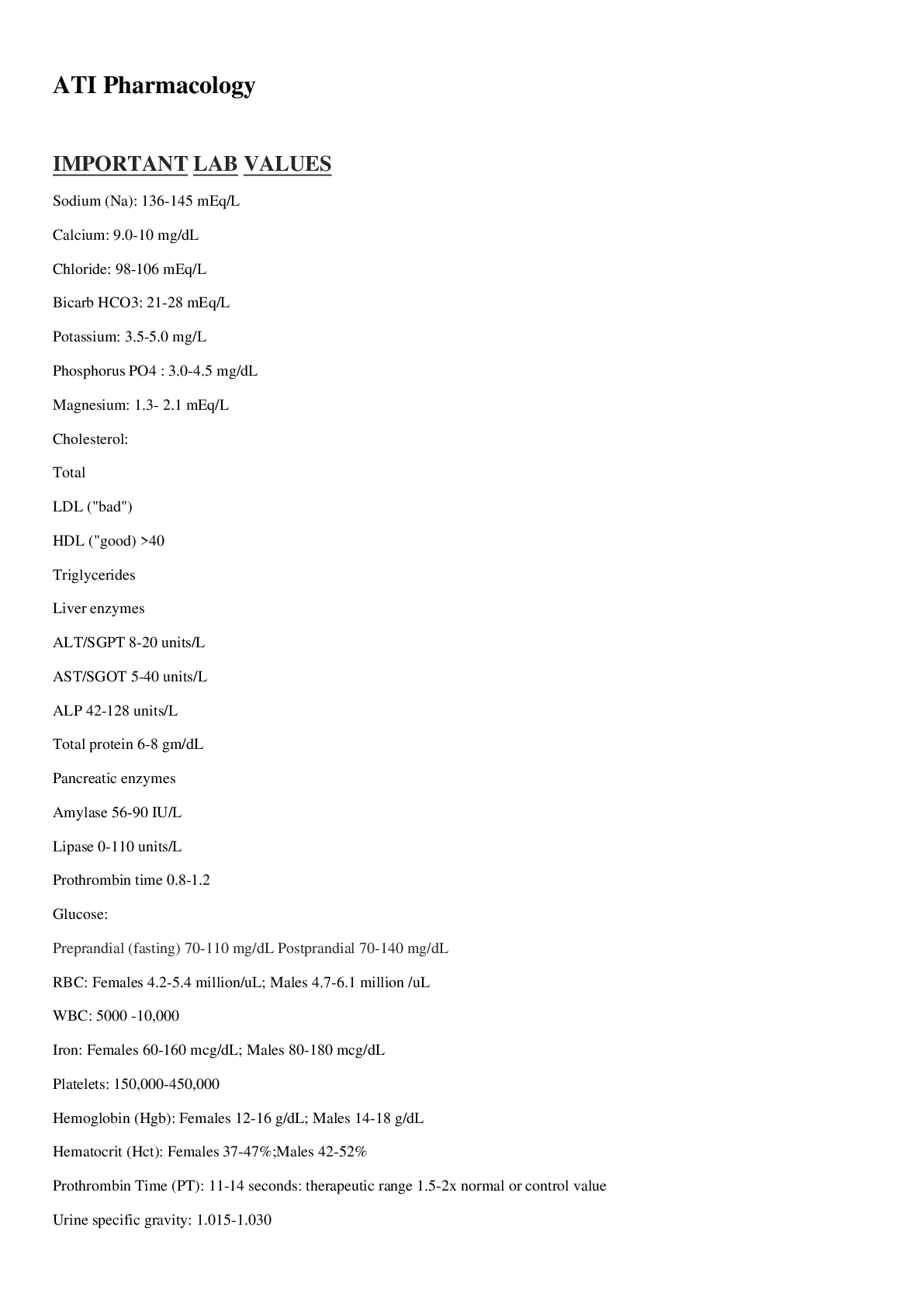


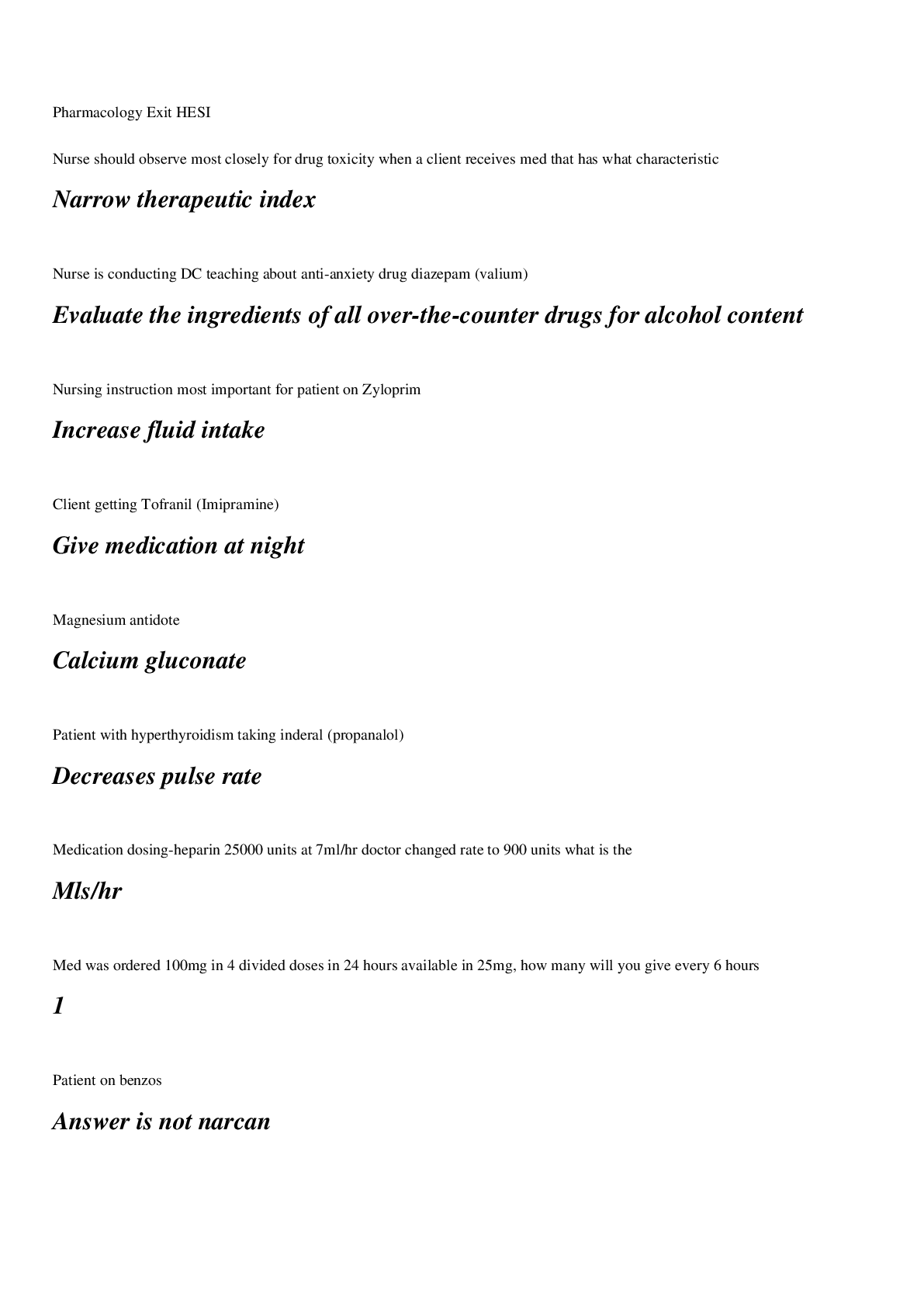

.png)




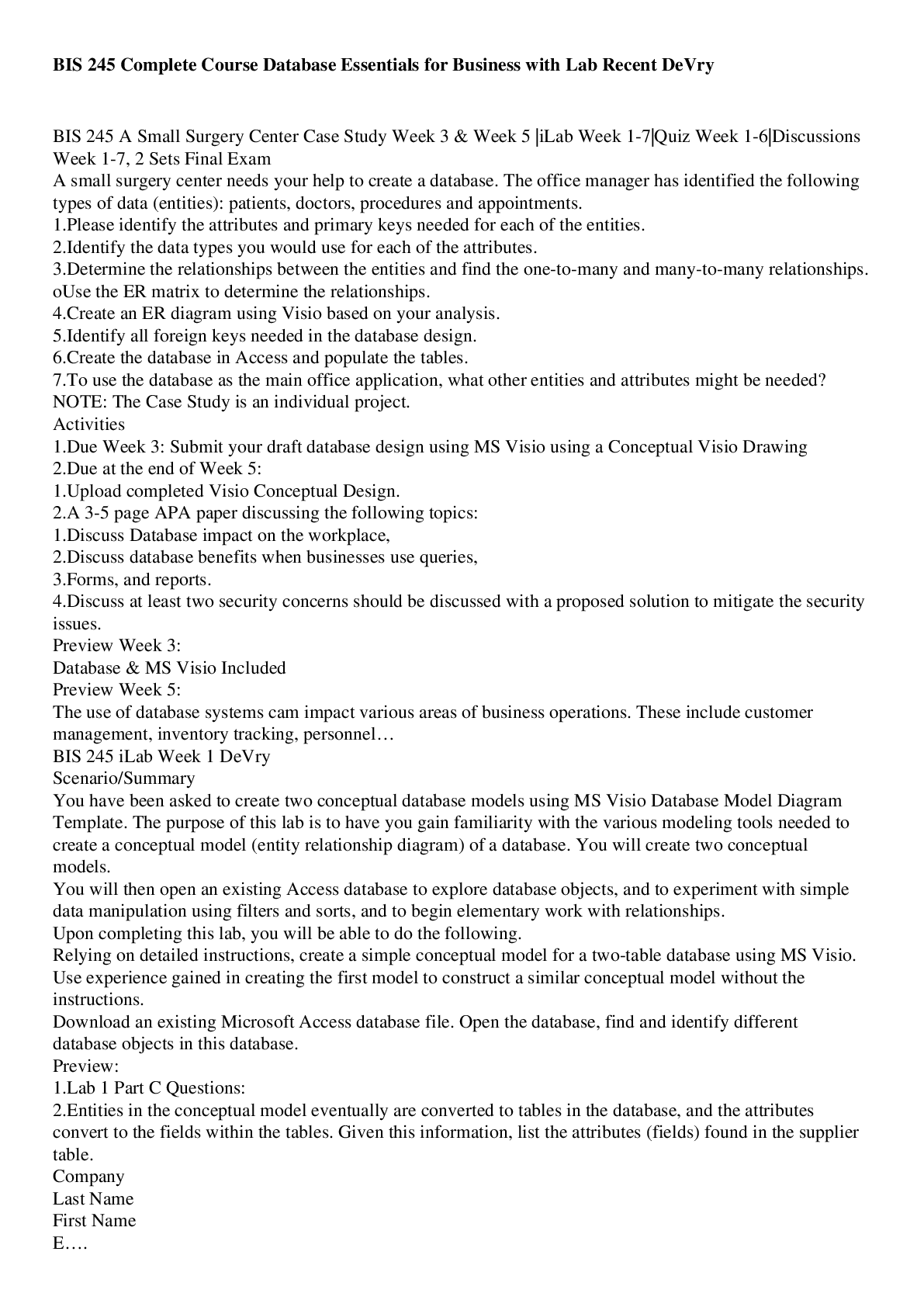
.png)

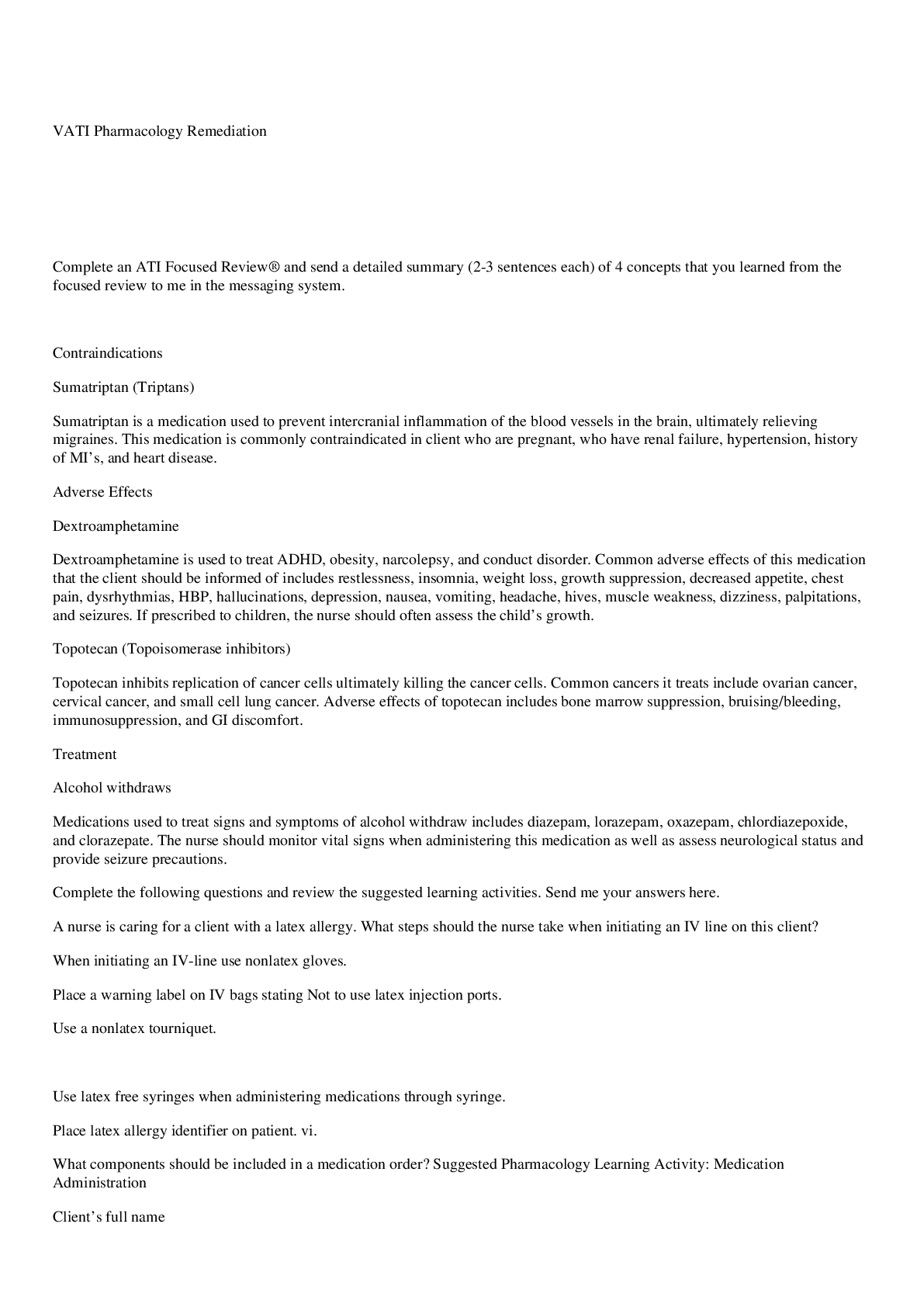




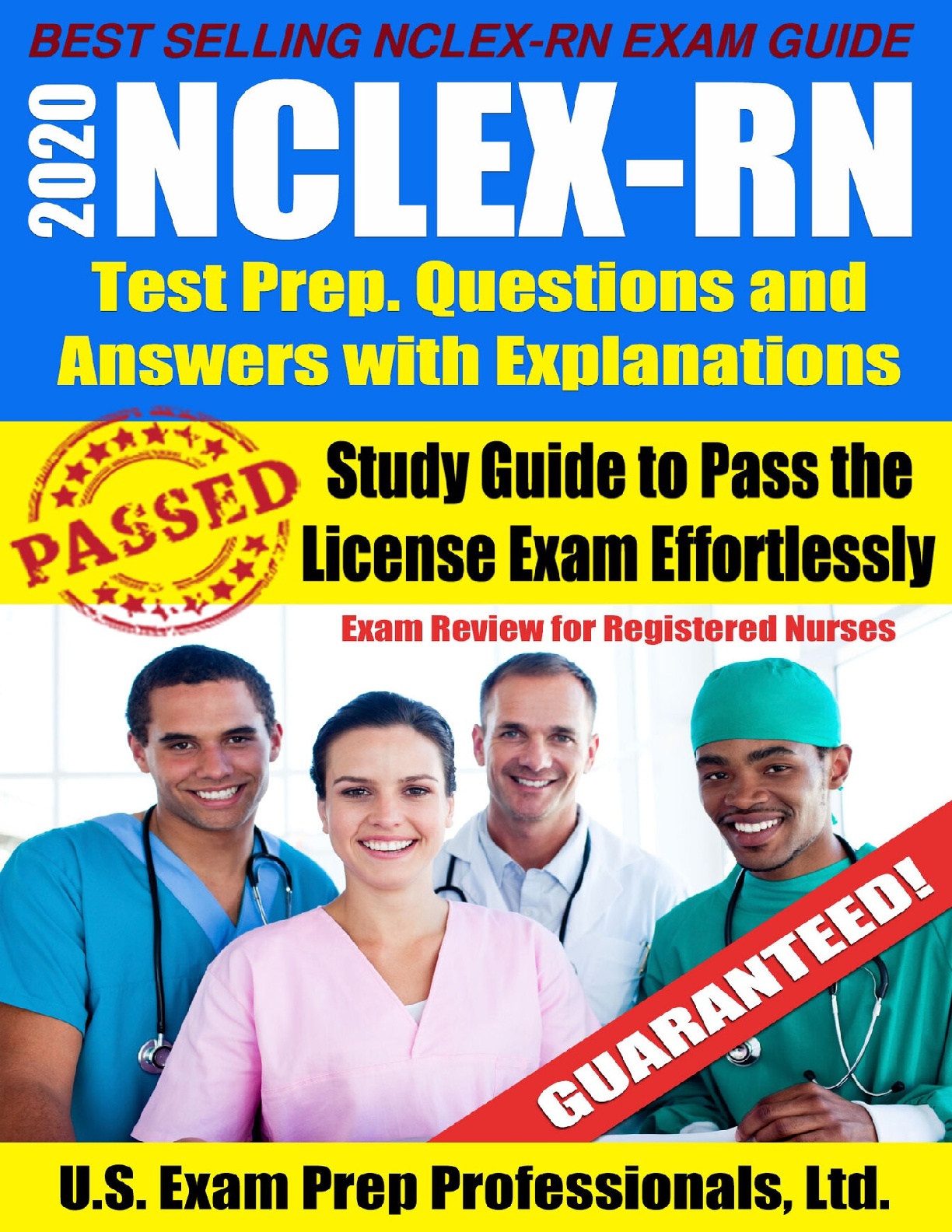

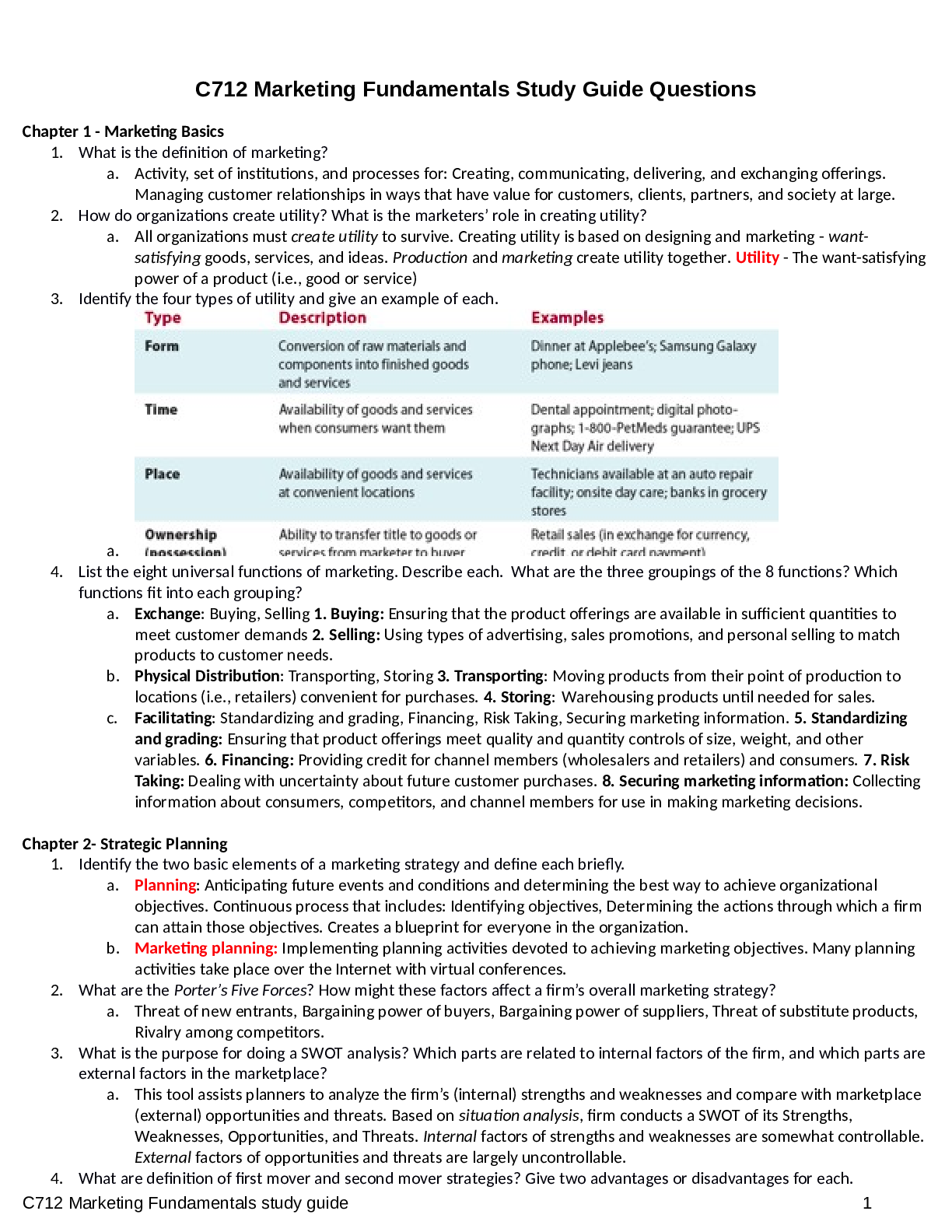
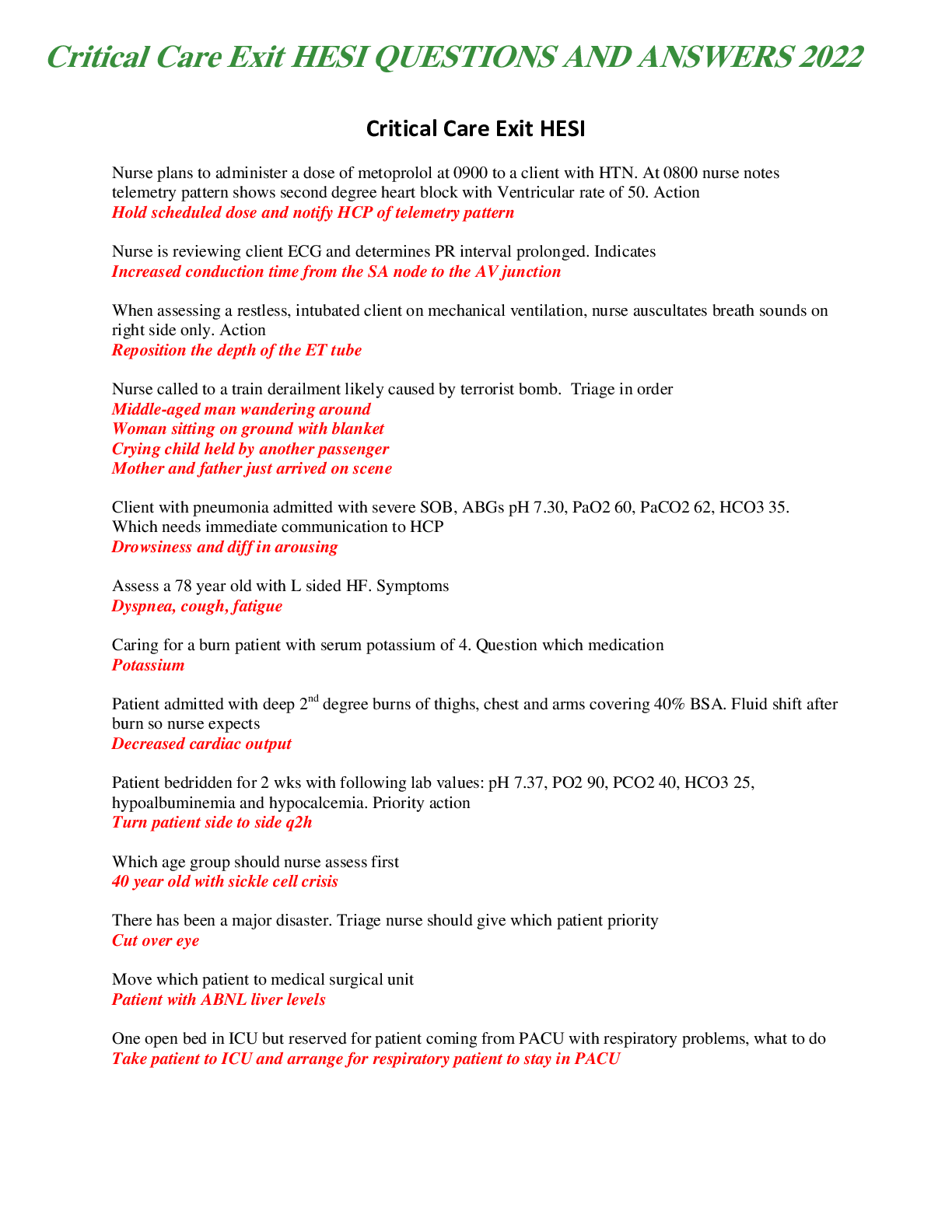

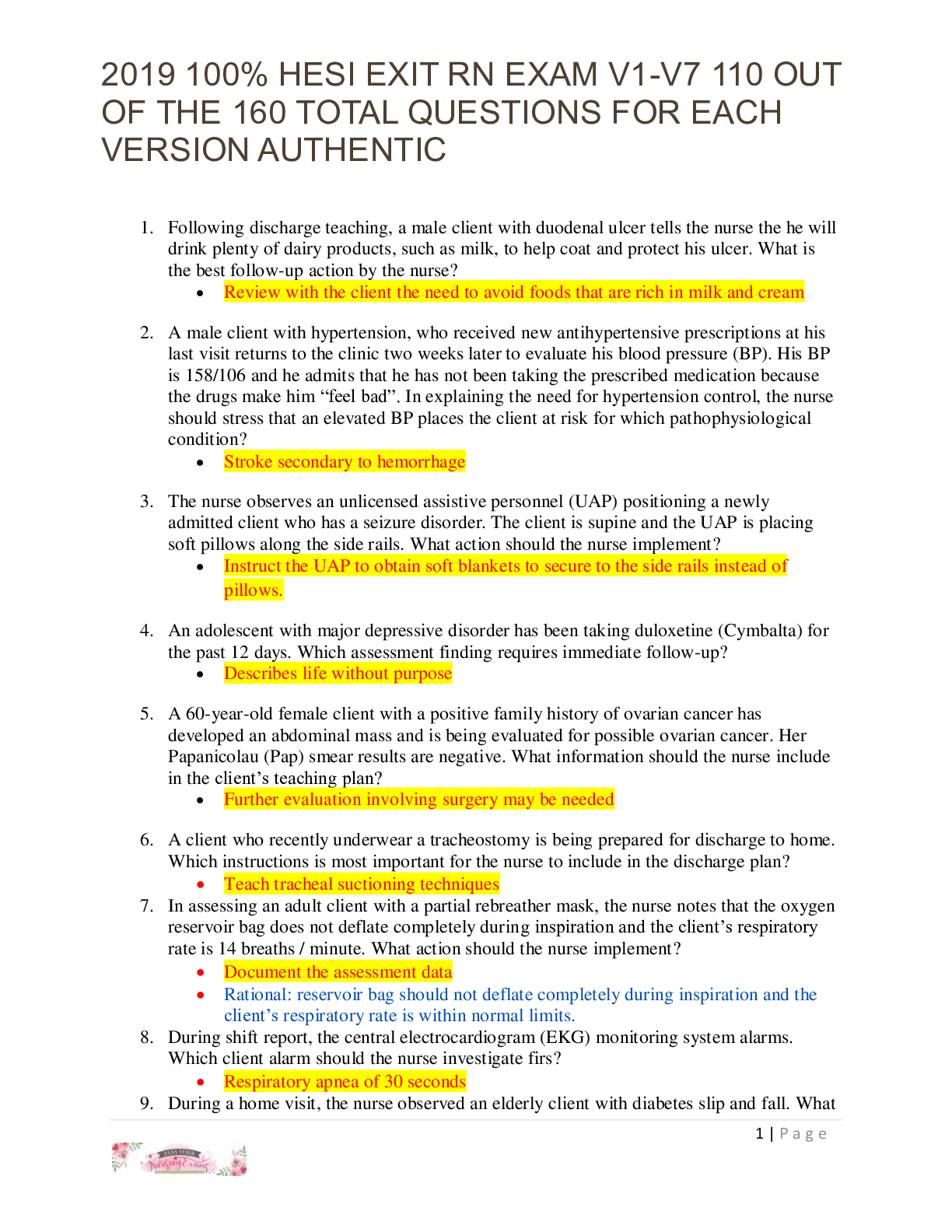

.png)
